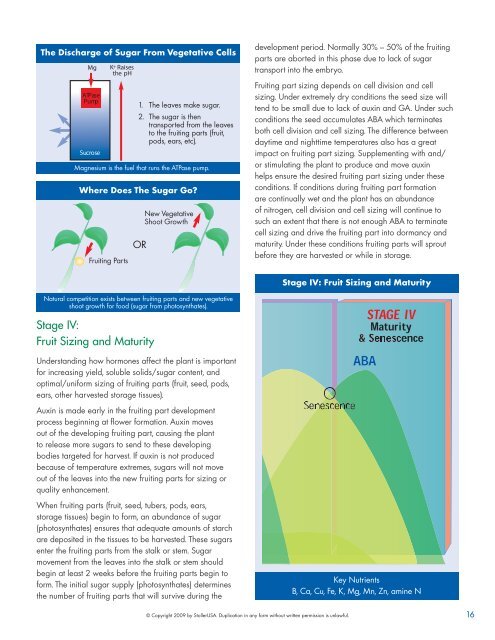Create successful ePaper yourself
Turn your PDF publications into a flip-book with our unique Google optimized e-Paper software.
The Discharge of Sugar From Vegetative Cells<br />
Mg<br />
ATPase<br />
Pump<br />
Sucrose<br />
K+ Raises<br />
the pH<br />
Where Does The Sugar Go?<br />
Fruiting Parts<br />
Stage IV:<br />
Fruit Sizing and Maturity<br />
1. The leaves make sugar.<br />
2. The sugar is then<br />
transported from the leaves<br />
to the fruiting parts (fruit,<br />
pods, ears, etc).<br />
Magnesium is the fuel that runs the ATPase pump.<br />
OR<br />
New Vegetative<br />
Shoot Growth<br />
Natural competition exists between fruiting parts and new vegetative<br />
shoot growth for food (sugar from photosynthates).<br />
Understanding how hormones affect the plant is important<br />
for increasing yield, soluble solids/sugar content, and<br />
optimal/uniform sizing of fruiting parts (fruit, seed, pods,<br />
ears, other harvested storage tissues).<br />
Auxin is made early in the fruiting part development<br />
process beginning at flower formation. Auxin moves<br />
out of the developing fruiting part, causing the plant<br />
to release more sugars to send to these developing<br />
bodies targeted for harvest. If auxin is not produced<br />
because of temperature extremes, sugars will not move<br />
out of the leaves into the new fruiting parts for sizing or<br />
quality enhancement.<br />
When fruiting parts (fruit, seed, tubers, pods, ears,<br />
storage tissues) begin to form, an abundance of sugar<br />
(photosynthates) ensures that adequate amounts of starch<br />
are deposited in the tissues to be harvested. These sugars<br />
enter the fruiting parts from the stalk or stem. Sugar<br />
movement from the leaves into the stalk or stem should<br />
begin at least 2 weeks before the fruiting parts begin to<br />
form. The initial sugar supply (photosynthates) determines<br />
the number of fruiting parts that will survive during the<br />
development period. Normally 30% – 50% of the fruiting<br />
parts are aborted in this phase due to lack of sugar<br />
transport into the embryo.<br />
Fruiting part sizing depends on cell division and cell<br />
sizing. Under extremely dry conditions the seed size will<br />
tend to be small due to lack of auxin and GA. Under such<br />
conditions the seed accumulates ABA which terminates<br />
both cell division and cell sizing. The difference between<br />
daytime and nighttime temperatures also has a great<br />
impact on fruiting part sizing. Supplementing with and/<br />
or stimulating the plant to produce and move auxin<br />
helps ensure the desired fruiting part sizing under these<br />
conditions. If conditions during fruiting part formation<br />
are continually wet and the plant has an abundance<br />
of nitrogen, cell division and cell sizing will continue to<br />
such an extent that there is not enough ABA to terminate<br />
cell sizing and drive the fruiting part into dormancy and<br />
maturity. Under these conditions fruiting parts will sprout<br />
before they are harvested or while in storage.<br />
Stage IV: Fruit Sizing and Maturity<br />
Key Nutrients<br />
B, Ca, Cu, Fe, K, Mg, Mn, Zn, amine N<br />
© Copyright 2009 by StollerUSA. Duplication in any form without written permission is unlawful. 16


